The Indigenous Employees' Circle (IEC) Newsletter

March 2019 Edition
Welcome Message from the IEC Chair
I am very excited to launch the Indigenous Employees' Circle (IEC) newsletter! It will inform and inspire you on a quarterly basis with exciting topics and news from across the Department and beyond. Each newsletter will be posted on our iService website. Maybe you know a colleague who may benefit from the information in our newsletter, please share!
The IEC is open to any employee who self-identifies as Indigenous (First Nation, Inuit or Métis). The IEC came together in 2010 to give Indigenous employee's the opportunity to discuss issues affecting us in the workplace; at local and national levels. Since these early days IEC members have been able to share information and network with each other through local regional representatives by email, national membership conference calls or attending some of the events organized by the IEC.
We want to keep in touch and share information on some important initiatives and topics taking place across the county. We want to share insights on the partners we have been working with and how we are progressing to support you, our member.
The newsletter is not just about the IEC National Council, it's about You! And we want to hear from you! We welcome your comments, story ideas, and topics of interest to you. As well, would you like to get involved? Maybe you have an idea or suggestion on how to become involved in your office but don't know where to start or you have a skill set you would like to utilize? Maybe you have a story idea you would like to share? Please let us know by email at: NC-AEC-CEA-GD.
Happy reading!
Reg Parsons
2019 International Year of Indigenous Languages:
The United Nations declared 2019 the Year of Indigenous Languages. It was declared for the purpose of encouraging action to preserve, revitalize and promote Indigenous languages across the globe. For more information about this, you can check out the Indigenous Languages website.
The IEC will be promoting the sharing of Indigenous languages for all of us to learn. We invite you to share your language. You can submit your language teaching to the IEC by sending us an email to: NC-AEC-CEA-GD. Please ensure to include the details of the language that you are sharing.
- Are you interested in learning an Indigenous Language? There have been a number of initiatives across Canada that has made learning available online. Check out these websites:
- Kanien'Kéha – An Open Source Endangered Language Initiative
- Gabriel Dumont Institute – Michif Learning Resources
- Learn Michif
- Haida Language Resource
- Learn Inuktut
- If you know of other resources that you would like to share with IEC members, send us an email to: NC-AEC-CEA-GD and we will include it in the next issue.
- "Ankita'si (I think)"
- A thought is to catch an idea
- Between two minds.
- Swinging to and fro
- From English to Native,
- Which one will I create, fulfill
- Which one to roll along until arriving
- To settle, still.
- I know, my mind says to me
- I know, try Mi'kmaw…
- Ankite'tm
- Na kelu'lk we'jitu (I find beauty)
- Ankite'tm
- Me' we'jitutes (I will find more)
- Ankita'si me' (I think some more)
- We'jitu na!*
- *We'jitu na! – I find!
- - Rita Joe
Meet the Indigenous Employees' Circle National Council
Executive Council

- Reg Parsons
- Chair
Reg is Inuit who has been working at ESDC since October 2015. He is currently the Service Manager with Employment Insurance. His career within the Federal Government started as a student in 1995, but he then moved into full time in 2002.
- "Be the change you want to see in the World"
- "Make it happen"
- "Many hands, light work"

- Glenda Restoule
- Vice-Chair
Glenda has worked at ESDC for a total of 9 years and is currently the Special Advisor, Indigenous Coordination and Engagement Division in the Indigenous Affairs Directorate. Glenda is Ojibwe or Anishnabe and her home community is Dokis First Nation in the Robinson Huron Treaty.
- "Stay calm, be brave and watch for the signs" ~Dead Dog Cafe
- "I'll stand my ground and I won't back down" ~Tom Petty

- Rochelle Burkowski
- Treasurer
Rochelle started working with HRDC as a student through the Native Internship Pro-gram in 1997. She is currently the Area Director for Southern Saskatchewan for Citizen Services in the WT Region. She is a member of the Beardy's and Okemasis First Nation.

- Jenny Anderson
- Secretary
Jenny is Cree from George Gordon's First Nation in Saskatchewan. She has been work-ing with ESDC since 1998 and is currently a Team Leader with Employment Insurance. Her passions are Indigenous issues, women's issues and mental health in the workplace.
Ontario Region

- Stephanie (Mikki) Adams
- Ontario Rep
Stephanie Mikki (Inuktitut name) Adams is an Inuk from the Kivalliq Region of Nunavut. Her hometown is Rankin Inlet, which is also the home of Jordin Tootoo. Mikki has recently moved to Ottawa and started with EDSC/IITB/Enterprise Solutions in October 2018 as Data & Reporting Analyst.
- "You miss 100% of the shots you don't take." ~Wayne Gretzky

- Dan Ducharme
- Ontario Rep
Dan has been working with ESDC since 2008 and his current position is Senior Citizen Services Specialist. He is a Dokis First Nation member and works out of the Citizen Services Branch in Sud-bury, Ontario.
- "La vie est belle"
- "Whether you think you can or can't you are right" ~Henry Ford
Western Territories Region

- Deb Foster
- Western Territories Rep
Deb is of Aboriginal Ancestry. She works as an Integrity Services Investigator with Integrity Services Branch in Victoria, BC. She is a big believer in respect for all human beings no matter what their heritage. She is honoured to have Indigenous heritage. She believes education is an im-portant consideration with our path forward towards Reconciliation.

- Ernest Mountain
- Western Territories Rep
Ernest started working for ESDC as an Acting Senior Program Delivery Officer in 2017, in the Aboriginal Skills & Employment Training Strategy (ASETS) program. He is Cree with some French from his Mother's side of the family. He is also a member of the Beaver Lake Cree Nation.
- "Back of every creation, supporting it like an arch, is faith.
Enthusiasm is nothing: it comes and goes.
But if one believes, then miracles occur" ~ Henry Miller
National Capital Region

- Natasha Bertrand
- National Capital Rep
Natasha is Eagle Clan, Mi'Kmaq; her Grandmother was taken out of Metepenagiag First Nation. She works with the Indigenous Affairs Directorate, SEB, in Gatineau. She started at ESDC with the Skills and Employment Branch in 2014.

- Nadine Solomon
- National Capital Rep
Nadine Solomon is Omushkego (Swampy Cree) from Fort Albany First Nation in northern Ontario. She began working for ESDC since 2015 and is currently a Policy Officer for the Indigenous Early Learning and Child Care Secretariat in Gatineau.
Quebec Region

- Josée Lebrun
- Quebec Rep
Josée is Algonquian of the Region of Maniwaki, native of Gatineau. She has worked as a Public servant since January 1988. She started as a typing clerk at the employment centre and since 2008 she works as a citizen service officer in Gatineau.

- Maryse Awashish
- Quebec Rep
Maryse is from Atikamekw First Nations and is a Payment Service Officer. She has been with ESDC since June of 2016
- If I speak, it has to mean something
Atlantic Region

- Fannie Bernard
- Atlantic regional Rep
Fannie who is of mixed Indigenous Ancestry joined ESDC in May of 1999. She is currently the Project Manager with the Atlantic Mental Health and Wellness team. She is focused on raising awareness about the IEC and Indigenous culture within ESDC.
- If it's in your power to do good, do good.
Indigenous Student Employment Opportunity (ISEO)
That time of the year is coming up quick where hiring managers need to start planning. The Federal Student Work Experience Program will be launching an Indigenous student summer inventory, known to students as Indigenous Student Employment Opportunity (FSWEP). This inventory will provide hiring managers with:
- resources and training to help them integrate their student(s)
- the flexibility to hire students permanently after graduation
- an opportunity to welcome diversity and new energy into the workplace
- an opportunity to invest in the future of federal public service
When? Managers will be able to request these students between February 18 and June 28, 2019. Stay tuned!
Need a student now? FSWEP's ongoing inventory is available to departments year-round. Contact the FSWEP team to make a request now or to learn more.
Other inventories available to you:
The PSC also offers year-round graduate inventories that include Indigenous and employment equity group talent. The Post-Secondary Recruitment Program will be bringing you thousands of pre-qualified candidates for entry-to mid-level positions. You'll be able to make requests as of February 12, 2019.
- Start thinking about how your organization can leverage these inventories to build a diverse and inclusive federal public service:
- Administrative Services
- Analyst (Policy, Economics and Social Sciences)
- Human Resources
- Information Management and Information Technology
- Sciences, Nursing and Engineering
- Technical Fields and Labour and Trades
Meanwhile you can continue to hire from the current Post-Secondary Recruitment PSR inventories.
About The IEC
Join the IEC:
The Indigenous Employees Circle is committed to achieving a culturally sensitive, inclusive and representative work environment while supporting collaborative initiatives and Government of Canada priorities.
The IEC is a forum for Indigenous employees and non-Indigenous employees of ESDC to network and learn about Indigenous related topics to connect with their Indigenous and non-Indigenous colleagues across the country. The IEC has a National Council that works with internal partners, in order to:
- Create a comfortable sense of community for Indigenous employees
- Promote awareness of Indigenous cultures
- Provide a forum for departmental consultation on issues and policies that impact First Nations, Métis and Inuit employees.
ESDC Employees:
- Opportunity to get involved, get informed and contribute to ESDC's success in achieving Reconciliation in the workplace
- Stay informed of news, events and learning opportunities available in your region
- Opportunity to voice concerns, ideas and suggestions
IEC Involvement:
- Indigenous Training and Awareness Activities
- Indigenous Awareness Week
- Indigenous Peoples Day Celebration
- Orange Shirt Day
- Moose Hide Campaign
- Indigenous Leadership Development
- Indigenous Recruitment
Indigenous Employees' Circle Photo Contest
Contest!
The IEC needs your help. We are working on improving our communications channels and we are going to be seeking out your talented eye. We want photos that feature your culture. It can be an event or things that are part of your traditions/culture. For each photo, please include your name, your location, your position, and details about the photo you submitted. The deadline to submit a photo will be April 30th, 2019. You can email your photos to: NC-AEC-CEA-GD
In-Person Meeting in Winnipeg
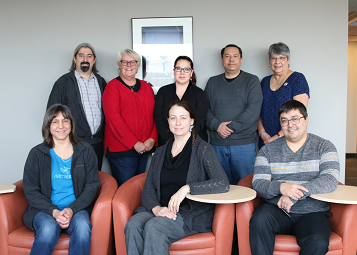
December 2018, Winnipeg, MB
The Indigenous Employees' Circle National Council had the opportunity to meet in person this past December at the 111 Lombard Cultural Centre where they were able to discuss the workplan and identify next steps. The National Council had the pleasure of learning from 111 Lombard Cultural Committee where they presented about employee engagement in cultural activities and they had participated in the Métis Rights Tour at the Canadian Museum for Human Rights. Reg, the Chair of the IEC National Council is looking to the future of the IEC and is optimistic about the work ahead. The In-Person meeting ended with an attitude of optimism and enthusiasm.
Métis Sharing and Learning at National Capital Region
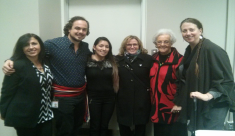
On November 16, 1885, 133 years ago, Louis Riel was hanged for treason by the Government of Canada under John A. Macdonald. To mark this event and celebrate the life of the great Métis leader, on November 15, Elder Reta Gordon and lawyer Jean Teillet (R. v. Powley) kindly presented "The Métis Nation of the North-West" to a very interested group of Employment and Social Services Canada (ESDC) employees. While Elder Gordon provided insightful and heart felt opening and closing words, Ms. Teillet helped steer the crowd through her vast knowledge of the Métis Nation.
By inviting Indigenous Peoples to share stories like these with their employees, the Government of Canada is demonstrating through concrete actions that they are slowly beginning to work with us toward reconciliation.
The ESDC Indigenous Employee Circle would like to thank Elder Gordon and Jean Teillet for taking the time to educate Government Employees about the Métis People. Through events like these, we hope that the relation between the Government of Canada and the Métis people will keep strengthening. "We can't go forward if we don't know our past."
- Reta Gordon
Note: In early 2019, don't forget to get your copy of Jean Teillet's new book The Métis Nation of the North-West that will be published by Harper Collins. This book promises to tell over 200 years of Métis history from a Métis perspective!
Article, by Réjean Belcourt
Western Territories Regional Highlights
Indian Residential School Interactive Map
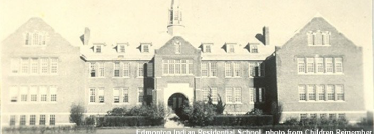
Edmonton Indian Residential School, St. Albert, Alberta, September 30, 1948. Photo credit: Library and Archives Canada
When I was approached with the idea of writing an article about the Indian Residential School Interactive Map, from the perspective of an Indigenous employee of ESDC, my first thought was that there wouldn't be much more for me to add that wasn't already covered in the CBC article, Was There A Residential School Near You?.
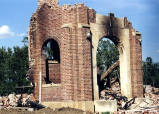
The ruins of the Edmonton Indian Residential School. Photo credit: Kathleen Steinhauer
With this in mind, I clicked on the link to the interactive map and followed the simple on-screen instructions. I entered the year I was born (that's a secret!) and the city of Edmonton address where I was born.
Expecting the results to take me to a residential school located far from Edmonton, I was surprised to see that the Edmonton Indian Residential School was just 14 kilometres away, near present day St. Albert. It was also known as Poundmaker, and was opened in 1924 and operated until 1966. I was further surprised by the fact that the interactive map also mentioned, based on my birth year, that when I started primary school, approximately 19 residential schools were still operating across Canada.
At this point my curiosity got the better of me. Wanting to know more I selected the "Show all schools" button and the screen transformed into a full-sized map of Canada revealing points all over our country where residential schools operated. My heart sank as I realized that not a single province or territory went untouched by a system that we now know sought to eradicate Indian, Inuit and Métis language and culture in a manner that left survivors broken and traumatized, as paraphrased in the Statement of apology to former students of Indian Residential Schools from then Prime Minister Stephen Harper.
Further web searches brought me to The United Church of Canada Archives site, where I found a comprehensive history of the schools that they operated. Upon reading their history of the Poundmaker, it was apparent that the children were used mainly as farm labourers with little to no academic instruction and many graduates could barely read or write.
The saddest part of the story for me was the cemetery. It was established on the school grounds to accommodate the burial needs of Indigenous and Inuit people who died at the Camsell Hospital and whose families could not afford to transport them back to their ancestral home. The young boys of the school were paid to dig the graves, but received no payment for maintaining the graveyard.
The school was repurposed throughout its history and was finally closed on June 30, 1968.
I would encourage everyone to try the Indian Residential School Interactive Map and also take the time to research the history of the school that you find was located near you. I appreciated that through reading the stories told of the suffering of the children I got a better perspective of the conditions that they endured. Ultimately, I found that I got a richer experience from this approach than I would have by simply using the interactive map.
Regards,
Ernest Mountain
Senior Development Officer, ASETS
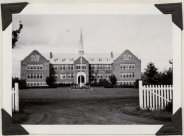
Edmonton Indian Residential School, St. Albert, Alberta, September 30, 1948. Photo credit: Library and Archives Canada
Atlantic Regional Highlights
What Reconciliation Means to Me
"You don't know poor, until you lived in the dorms."
Over my lifetime, I have worn many hats, played many roles, and had many jobs, which have brought me to today. Currently within ESDC, I am a Payment Services Officer (PSO) located in the St. John's, NL Call Centre. But first and foremost, I am an Indigenous daughter, woman and mother.
The Truth and Reconciliation Commission brought forward to all of Canada the harm done by residential schools; to the people who lived through them, and the generations that followed.
I am one of those people.
My mother was raised in a residential school, sent at age 8 until she was 18. She does not talk much about "the dorms" as it was referred too, and I would only hear a comment here and there about the strict dorm mothers, or "you don't know poor until you lived in the dorms." It was something not openly discussed.
My mother remains silent.
It was not until I had my own children that I came to the full realization of what she must have gone through, and how being raised in an institution really affected behaviours, ambitions and relationships. I was raised to not question authority figures, and accept their statements as to be true. To have personal ambitions were not discussed; and to accept where we were as it; wanting something different was not an option. Expressions of emotions and knowing how to respond were difficult. When I became a parent, I had to consciously make a decision to express and show emotions with my children. I had to be consciously aware, supportive, and understanding. These traits are absent to many affected by residential schools. When my oldest child turned 9 this year, it really played on my mind. It was at that moment that I realized had he been born during my mother's generation he would not be with me, and would have been living in a dorm far from me for a year. The bond between parent and children is needed from a young age throughout their lifetime. People need to develop a sense of belonging, this is especially important for indigenous people, to be grounded with a sense of identity in an ever-changing world.
The "dorms" affected generations.
When looking at Reconciliation, to me it means a new beginning while remembering the past. I know it begins with me, to educate my children, my peers and community. Being one Indigenous person with a voice can open doors for others to speak up and be heard. Taking control and standing up for decisions that affect me should always include me. When raised in a home and a community where you avoid conflict, especially where there are authority figures, it is hard but I have to do it.
I have a voice and will speak when others cannot.
Teresa Evans
Payment Services Officer, Benefit Delivery Services Branch
Quebec Regional Highlights
A Message From Your Regional Representative

"Maliotenam Indian Residential School, children and nuns in front of the school, Sept-Îles, Quebec, ca. 1950"
I had the pleasure to build a presentation for every team at the Shawinigan call centre about Residential school. Many of my colleagues never heard of what happened back then, or even knew that residential schools were a thing. The presentation was heavy and had saddened many people but we got a lot of good feedback. We may be doing another presentation early next year and we hope that it will reach your expectations for those that are attending.
I also wish to gather your comments about the Moose hide campaign, we were very time limited and only a few of us had the chance to have pins to distribute. We will plan ahead for the next activities! You can send your comments and requests to our general IEC mailbox or email them to me directly.
Maryse Awashish
Ontario Regional Highlights
Moose Hide Campaign Reflection

As I sit here fasting over lunch as a personal commitment to honor and protect the women and children in my family, organizations and communities, I contemplate the effect of my actions on my sons. I shared a small bundle of Moose Hide pins with my oldest son that is in tenth grade. He renewed a sense of hope in me this morning when he told me that he need more pins and that he presented the Moose Hide Campaign in his French and Math class.
I encourage you all to take time today and every day to reflect on how and what we can do to stand up against violence towards women and children and to talk to the young men and boys in your life to effect change. Attached are posters of the Moose Hide Campaign and even though there is a National Gathering and Day of Fasting in Ottawa today you can still order pins and take part in the Moose Hide Campaign because this is a year round issue.
Miigwetch
Daniel Ducharme
Indigenous Inventory
An ESDC Indigenous Inventory was launched in 2018 for Indigenous employees from across Canada who currently work in the Federal Public Service and are interested in job opportunities at the same or equivalent group and level within ESDC (assignment, secondment, deployment) and other organizations within the core public administration.
All Indigenous Employees who are interested in new work experiences are encouraged to apply online. For more information, you can contact: NC-REPERTOIREAUTOCHTONE-NONEX-INDIGENOUSINVENTORY-GD
Inuit Life and Culture Sharing Workshop
On Wednesday February 13, 2019, the Indigenous Employee Circle (IEC) was proud to host an Inuit Life & Culture awareness learning session at the Indigenous Cultural Centre (ICC) in Edmonton, Alberta. Through a partnership with Indigenous Services Canada (ISC) this session was made available to Service Canada employees via video conference in Brandon, MB, Regina, SK, Prince Albert, SK, Nanaimo BC, and Vancouver, BC.
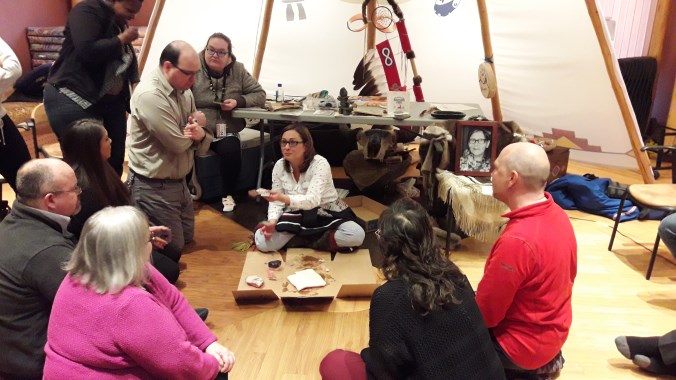
Elder Goota Desmarais sharing knowledge at the ICC
Inuit Elder, Goota Desmarais of Inuit Connections delivered a powerful presentation of Inuit life and culture. Dressed in a traditional baby carrier, called and amouti, she passionately shared her culture through storytelling and the use of authentic Inuit artifacts and foods. If you are interested in learning more about this exciting experience please read the article "Goota Desmarais' Talk on Inuit Life an Emotional Eye Opener" written by Isaac Bell, Program and Services Delivery Clerk for Indigenous Program Delivery in Edmonton. The article was published in the March 6, 2019 edition of It's All About You (IAAY).
Ernest Mountain
IEC Western Territory Representative
Western Territories Team Lead Forum
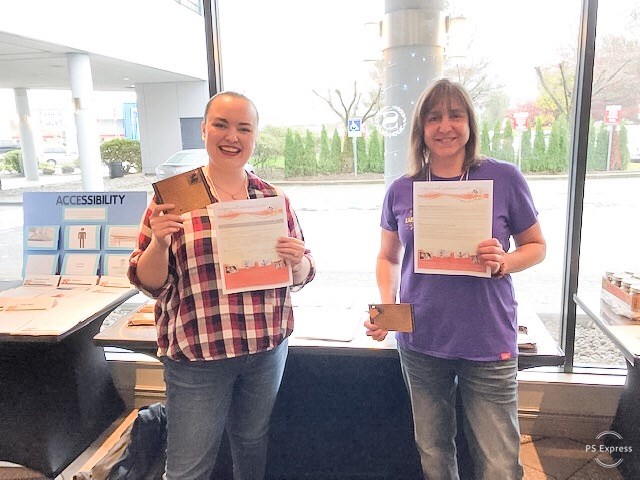 Jenny Anderson promoting IEC
Jenny Anderson promoting IECJenny Anderson, the IEC Secretary was at the Western Territories Team Leader Forum in November 2018. The theme of the forum was "Diverse and Dynamic Leadership" and this provided a variety of learning activities for the Western Territories Team Leads. This two day event also offered networking opportunities where they could engage with speakers from Labour Relations, OICM, the Office of Values and Ethics, Informal Conflict Management, Official Languages, Saba Team and Strategic Services. A number of Indigenous activities and topics were presented at this event. The IEC is always looking for ways to share information and get involved with the Department.
IEC FAQ's
What is the difference between a "Member" and "Friend, Partner, Affiliate Member"?
A "Member" is an employee who self-identifies as Aboriginal or Indigenous. Under the Employment Equity Act, Aboriginal is defined as: First Nations, Métis, or Inuit
A "Member" is granted certain rights and privileges as outlined in the Terms of Reference such as the right to vote on important decisions, the ability to put their name forward for any of the Executive Committee or National Council positions, and the right to be represented by the IEC.
A "Friend, Partner, Affiliate Member" is an employee that does not self-identify as an Aboriginal or Indigenous person, however, they are still able to participate in National Council meetings as an observer and receive/share information through the IEC network. They do not have any voting privileges during the National Council meetings and they are not eligible to apply or run for any Executive or National Council positions.
What is an Alumni Member?
An Alumni member is a designation that is granted to an IEC member who is no longer an employee of ESDC but is still interested in supporting the efforts and partnerships created within the IEC. They are still able to receive updates and participate in National Council meetings as an observer but do not have any voting privileges. They are also not eligible to apply or run for any Executive Committee or National Council positions.
To be an Alumni member, you must submit a special request to the IEC National Council.
Are there any fees to join?
No, there is no cost to join the IEC. You just need to email a completed application from the IEC Intranet site.
How to become a Member:
Email the completed application form found on the IEC Intranet site and send it to: NC-AEC-CEA-GD
